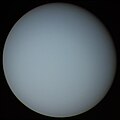天卫三
 航海家2號所攝影的天卫三 | |||||||||
| 发现 | |||||||||
|---|---|---|---|---|---|---|---|---|---|
| 發現者 | 威廉·赫歇爾 | ||||||||
| 發現日期 | 1787年1月11日[1] | ||||||||
| 編號 | |||||||||
| 形容詞 | Titanian /təˈtɑːniən/[3][註 1] | ||||||||
| 軌道參數 | |||||||||
| 半長軸 | 435910 km[4] | ||||||||
| 離心率 | 0.0011[4] | ||||||||
| 軌道週期 | 8.706234 d[4] | ||||||||
| 平均軌道速度 | 3.64 km/s[註 2] | ||||||||
| 軌道傾角 | 0.340° (to Uranus's equator)[4] | ||||||||
| 隸屬天体 | 天王星 | ||||||||
| 物理特徵 | |||||||||
| 平均半徑 | 788.4±0.6 km (0.1235 Earths)[5] | ||||||||
| 表面積 | 7820000 km2[註 3] | ||||||||
| 體積 | 2065000000 km3[註 4] | ||||||||
| 質量 | (3.400±0.061)×1021 kg[6] | ||||||||
| 平均密度 | 1.711±0.005 g/cm3[5] | ||||||||
| 表面重力 | 0.366 m/s²[註 5] | ||||||||
| 0.758 km/s[註 6] | |||||||||
| 自轉週期 | 潮汐鎖定(假定)[7] | ||||||||
| 反照率 |
| ||||||||
| |||||||||
| 視星等 | 13.9[9] | ||||||||
| 大氣特徵 | |||||||||
| 表面氣壓 | <1–2 mPa (10–20 nbar) | ||||||||
| 成分 | |||||||||
天卫三(緹坦妮雅、Titania、发音为/tɨˈtɑːnjə/ /taɪˈteɪniə/)是天王星最大的衛星,也是太陽系內第八大的衛星。直徑為1,578公里(981英里),。1787年由威廉·赫歇爾發現,並以威廉·莎士比亚的《仲夏夜之夢》中的妖精王后緹坦妮雅命名。它的軌道位於天王星的內部磁層。
天卫三由大約等量的冰和岩石組成,可能分為岩石核心和冰冷的地幔,在核幔邊界處可能存在一層液態水。表面相對較暗,顏色略帶紅色,似乎是由于内部的水冻结、膨胀,撑裂了薄弱的外壳而形成的。表面覆满了火山灰。这表明曾发生过火山活动。那儿有长达数千公里的大峡谷,此外它的表面也被一种黑色物质重新覆盖过,可能是甲烷或水冰。天卫三覆蓋著無數直徑達326公里(203 英里)的撞擊坑,但隕石坑的數量並不如天卫四多,並表示天王星的五個衛星它可能經歷了早期的內源性表面重生事件,抹去較舊的、嚴重坑坑洼窪的表面。像天王星的所有主要衛星一樣,天卫三可能是由一個吸積盤形成的,該吸積盤在其形成後就圍繞著這顆行星。
從2001年到 2005 年進行的紅外光譜顯示,天卫三表面存在水冰和凍結的二氧化碳,這表明它可能具有表面壓力約為10納帕(10 -13巴)的稀薄二氧化碳。在天卫三掩星期間的測量將任何可能大氣的表面壓力上限設置為1-2 mP)(10-20 nbar)。
1986年1月,航海家2號僅對天王星系統進行了一次近距離研究。並拍攝了幾張天卫三的圖像,從而可以觀測其約40%的表面。
發現
[编辑]天衛三緹坦妮雅是威廉·赫歇爾在1787年1月11日發現的,同一天也發現了奧伯龍[10];他後來又報告發現四顆衛星,結果是錯誤的[11]。
命名和格調
[编辑]
天衛三緹坦妮雅和其他四顆衛星的名字是約翰·赫協爾在1852年應在當年稍早時發現艾瑞爾和烏伯瑞爾的威廉·拉塞爾要求而命名的[12]。拉塞爾早在1847年就支持赫歇爾為已知的七顆土星衛星和依據赫協爾的命名計畫在1848年將新發現的第八顆衛星命名為哈佩力恩。
天王星所有的衛星都依據英國詩人莎士比亞或蒲伯劇作中的人名。天衛三緹坦妮雅的名稱來自《仲夏夜之夢》的緹坦妮雅,是小仙子們的皇后。
莎士比亞劇中角色的名稱读作/tɨˈtɑːnjə/,但是由于家喻戶曉的化學元素鈦,這顆衛星的名稱常常被读作/taɪˈteɪniə/。其與土衛六泰坦的形容詞同為Titanian,它也稱為天衛 III。
表面特徵
[编辑]到目前為止,天衛三緹坦妮雅唯一清楚的一張相片是來自航海家2號太空船,是在1986年1月飛掠而過時拍攝的。當時這顆衛星是以南半球朝向太陽,因此觀測不到北半球。
雖然不清楚它內部的構造,有一種模型認為天衛三緹坦妮雅大致由50%的碎冰、30%的矽酸鹽岩石和20%和甲烷相關的有機化合物組成。表面主要的特徵是巨大的峽谷,像是地球上大峽谷的縮影,其規模與火星上的水手號峽谷,或是土星的衛星泰塞斯的伊薩卡峽谷一樣。
深谷
[编辑]天衛三緹坦妮雅上的深谷,以莎士比亞作品中出現的地名命名。
| 名稱 | 坐標 | 長度(公里) | 名字來源 |
|---|---|---|---|
| 貝爾蒙深谷 | 8°30′S 32°36′E / 8.5°S 32.6°E | 238 | 貝爾蒙泰卡拉布羅,義大利城市,出現於威尼斯商人。 |
| 墨西拿深谷 | 33°18′S 335°00′E / 33.3°S 335°E | 1,492 | 墨西拿,義大利城市,出現於無事生非。 |
斷崖
[编辑]天衛三緹坦妮雅上的斷崖,以莎士比亞作品中出現的人物命名。
| 名稱 | 坐標 | 長度(公里) | 名字來源 |
|---|---|---|---|
| 胡西雍斷崖 | 14°42′S 23°30′E / 14.7°S 23.5°E | 402 | 胡西雍,法國山城,出現於皆大歡喜。 |
撞击坑
[编辑]天衛三緹坦妮雅上的撞击坑,以莎士比亚作品中出現的人物命名(注:以下中文人名均引自梁实秋译《莎士比亚全集》,2002年1月中国广播电视出版社出版)。
掩星
[编辑]天衛三緹坦妮雅在2001年9月8日掩蔽了一顆黯淡的星,這是測量它的直徑和星曆表,以及檢測是否存在著任何大氣層的好機會。數據顯示表面的壓力沒有超過0.03微帕,因此沒有大氣層,即使有也比冥王星和海衛一更稀薄 [13][14]。
註解
[编辑]參考資料
[编辑]- 註釋
- ^ 拼寫與土星衛星的形容詞形式土衛六相同,但發音可能不同。
- ^ Calculated on the basis of other parameters.
- ^ Surface area derived from the radius r : 4πr².
- ^ Volume v derived from the radius r : 4πr3/3.
- ^ Surface gravity derived from the mass m, the gravitational constant G and the radius r : Gm/r².
- ^ Escape velocity derived from the mass m, the gravitational constant G and the radius r :
- 來源
- ^
Herschel, W. S. An Account of the Discovery of Two Satellites Revolving Round the Georgian Planet. Philosophical Transactions of the Royal Society of London. 1787, 77: 125–129. JSTOR 106717. doi:10.1098/rstl.1787.0016
 .
.
- ^ Template:Lexico Lexico/OED. Only the first pronunciation is used in A Midsummer Night's Dream, e.g. Shakespeare Recording Society (1995) The Tempest (audio CD). The second is used by interviewees in a podcast by the Folger Shakespeare Library, but not by the narrator: Brave New Worlds: The Shakespearean Moons of Uranus (页面存档备份,存于互联网档案馆)
- ^ Lewis (2002) Anthony Burgess: A Biography, p. 387
- ^ 4.0 4.1 4.2 4.3 Planetary Satellite Mean Orbital Parameters. Jet Propulsion Laboratory, California Institute of Technology. [2009-10-06]. (原始内容存档于2013-11-03).
- ^ 5.0 5.1 5.2 Widemann, T.; Sicardy, B.; Dusser, R.; Martinez, C.; Beisker, W.; Bredner, E.; Dunham, D.; Maley, P.; Lellouch, E.; Arlot, J. -E.; Berthier, J.; Colas, F.; Hubbard, W. B.; Hill, R.; Lecacheux, J.; Lecampion, J. -F.; Pau, S.; Rapaport, M.; Roques, F.; Thuillot, W.; Hills, C. R.; Elliott, A. J.; Miles, R.; Platt, T.; Cremaschini, C.; Dubreuil, P.; Cavadore, C.; Demeautis, C.; Henriquet, P.; et al. Titania's radius and an upper limit on its atmosphere from the September 8, 2001 stellar occultation (PDF). Icarus. February 2009, 199 (2): 458–476 [2022-06-09]. Bibcode:2009Icar..199..458W. doi:10.1016/j.icarus.2008.09.011. (原始内容 (PDF)存档于2014-07-25).
- ^ R. A. Jacobson (2014) 'The Orbits of the Uranian Satellites and Rings, the Gravity Field of the Uranian System, and the Orientation of the Pole of Uranus'. The Astronomical Journal 148:5
- ^ Smith, B. A.; Soderblom, L. A.; Beebe, A.; Bliss, D.; Boyce, J. M.; Brahic, A.; Briggs, G. A.; Brown, R. H.; Collins, S. A. Voyager 2 in the Uranian System: Imaging Science Results. Science. 4 July 1986, 233 (4759): 43–64 [2022-06-09]. Bibcode:1986Sci...233...43S. PMID 17812889. S2CID 5895824. doi:10.1126/science.233.4759.43. (原始内容存档于2018-10-23).
- ^ Karkoschka, Erich. Comprehensive Photometry of the Rings and 16 Satellites of Uranus with the Hubble Space Telescope. Icarus. 2001, 151 (1): 51–68. Bibcode:2001Icar..151...51K. doi:10.1006/icar.2001.6596.
- ^ Newton, Bill; Teece, Philip. The guide to amateur astronomy. Cambridge University Press. 1995: 109. ISBN 978-0-521-44492-7.
- ^ Herschel, "An Account of the Discovery of Two Satellites Revolving Round the Georgian Planet", Philosophical Transactions of the Royal Society of London, Vol. 77, pp. 125-129, 1787; and "On George's Planet and its satellites", Philosophical Transactions of the Royal Society of London, Vol. 78, pp. 364-378, 1788.
- ^ "On the Discovery of Four Additional Satellites of the Georgium Sidus; The Retrograde Motion of Its Old Satellites Announced; And the Cause of Their Disappearance at Certain Distances from the Planet Explained", Philosophical Transactions of the Royal Society of London, Vol. 88, pp. 47-79, 1798.
- ^ Beobachtungen der Uranus-Satelliten. Astronomische Nachrichten. 1852-06-01, 34: 325 [2022-04-11]. ISSN 0004-6337. (原始内容存档于2022-04-07).
- ^ Atmosphere around Titania?. Observatoire de Paris - PSL Centre de recherche en astronomie et astrophysique. [2022-04-11]. (原始内容存档于2013-02-08).
- ^ LESIA - Observatoire de Paris. [2022-04-11]. (原始内容存档于2007-02-24).
外部連結
[编辑]- Titania profile. NASA. 1999 [June 22, 2009]. (原始内容存档于June 13, 2009).
- NASA archive of publicly released Titania images (页面存档备份,存于互联网档案馆)
- Sicardy, Bruno; Widemann, Thomas. Is there an atmosphere around Titania, satellite of Uranus?. Paris Observatory. 2001 [June 22, 2009]. (原始内容存档于March 7, 2013).
- Widemann, Thomas. From Titania to large trans-Neptunian objects: ground-based stellar occultations in the quest for the billionth of atmospheric pressure. Paris Observatory. 2009 [June 22, 2009]. (原始内容存档于June 4, 2011).
- Titania page (页面存档备份,存于互联网档案馆) (including labelled (页面存档备份,存于互联网档案馆) maps (页面存档备份,存于互联网档案馆) of Titania) at Views of the Solar System
- Titania nomenclature (页面存档备份,存于互联网档案馆) from the USGS Planetary Nomenclature web site (页面存档备份,存于互联网档案馆)




